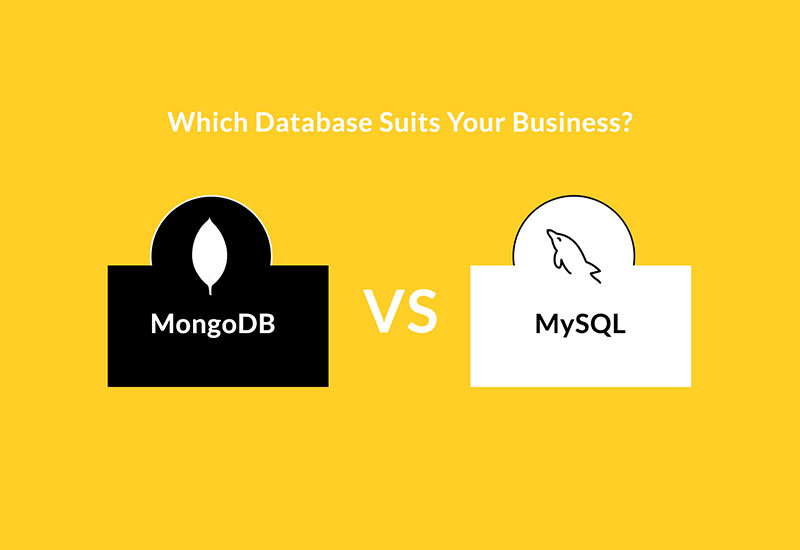April 3, 2021 | MongoDB Vs MySQL: Which Database Suits Your Business?

As the data is continuing to be more diversified, multifaceted, and voluminous, non-relational databases like MongoDB are gaining popularity. This new class of non-relational database has brought with itself a stiff competition between the two – a newbie vs a veteran: MongoDB vs MySQL. Whether you are considering database technology for a software solution, the choice is limited to two main databases. Companies needing a robust relational database at a cheap cost mostly prefer the MySQL database. Usually, the entrepreneurs are aware of the business part, what they miss to understand is the technical viability and proper implementation of the concepts technically.
On the other side, we should not forget about the competition in the mobile app industry. Based on the requirements of your organization, you also have to carefully choose a perfect database model for the best results. Here in this blog, We have compared two database management systems that will help you have a better concept about their applications.
MongoDB is an open-source database that was developed in 2007. Then it came to be known as MongoDB Inc. It is a popular SQL database that is currently used by many organizations. MongoDB creates and stores data in JSON -like documents that may have distinct structures. To improve efficiency and query speed, the database can store all the related data together that can be easily accessed using MongoDB query language. Additionally, MongoDB is schema-free. Besides, the JSON format allows for the seamless transfer of data between web apps and servers with the use of the human-readable format.
What is MySQL?
MySQL is an open supply RDBMS, (relational database management program), MySQL has gained in-depth recognition more than the years. In any case, it was worked by MySQL AB. MySQL is a veteran as it has been in the IT scene since 1995.
Like other social DBMSs, MySQL utilizes SQL (basic inquiry language) to get the database’s entrance alongside keeping information put away in tables. In MySQL, the client can pre-characterise the database conspire dependent on the prerequisites to set up decides that can administer the relationship among all the applicable fields in the tables.
What is MongoDB?
MongoDB was created by MongoDB, Inc and is one of the most popular documents oriented database under the NoSQL database. It was first released in the year 2019 and is developed. Information is stored in this variety of DBMS as documents in a kind known as BSON (a variety of binary representation). The MongoDB query language is generally used to store related data for query access. In this, the fields are different for each document, and you won’t need to require to declare the document structure to the systems. As an outcome, developers locate it straightforward to master and use.
MongoDB vs. MySQL: Identifying the Best Fit
When to use MySQL?
- If you’re just starting your business and in which case, the database won’t scale that much.
- If you have a data structure that is not going to change over the period.
- If you have a fixed schema.
- If you’re looking for top-notch performance ability on a lower budget.
- If you require a high transaction rate.
- If data security is your top priority.
- In case you’re simply beginning your business and in which case, the database won’t scale that much.
- If you have an information structure that won’t change over the period.
- If you have a fixed diagram.
- In case you’re searching for first-class execution capacity in a lower spending plan.
- If you require a high exchange rate.
- If information security is your top need.
When to use MongoDB?
For applications that use and require real-time analytics, applications based on IoT, and content management, MongoDB appears to be a good choice. At the point, when you need high information alongside programmed, fast, and moment information recuperation. In case, you need to bring down the expense of pattern movement.
One of the factors, that your administration is for the most part cloud-based, MongoDB would come convenient for your business because of its local scale-out design. Another factor that design is controlled by shading with the level scaling and offered through distributed computing.
Advantages-
- No need to define the schema during the design phase
- Use documents to store unstructured data that is easier to update and retrieve.
- The database schema is unstable but the database is growing
- No need for data administrators
A mature relational database or a young, non-relational system. Which one should you choose?
In MongoDB, you don’t need to take the system to the offline mode as the central system catalogue doesn’t require any update. Moreover, you can also enforce the data control on all the collections by optionally using the schema validation. Moreover, this NoSQL solution comes with added benefits of on-board replication and auto-sharding embedding that enhances the availability and scalability.
Let us compare the two databases side-by-side in different scenarios to identify the most suitable fit for your business needs.
Database Structure
In MySQL database structure stores the data values in tables and makes use of SQL to access them. It uses schema for defining database structure. The prime requirement of the schemas is that the rows have the same structures inside the table, It also requires its values to be represented by specific data types. Let’s discuss the database structure of both MongoDB and MySQL. Schema is used to define the database structure. Whereas, in the MongoDB database, the data is stored in JSON-like documents that come in varied structures. To boost up the query speed, it stores the related data sets together which are then accessed by using the MongoDB query language.
The database is schema-free, which means that the mobile app developers don’t have to define any document structures for creating the documents. The database is without a pattern, which implies that the portable application designers don’t need to characterize any record structures for making the archives.
Index Optimization
Both MongoDB and MySQL use indexes for finding data quickly. The difference in approach, however, comes when an index is not found or defined.In the case of MySQL when the file isn’t characterized by file streamlining, the database motors examine the whole table to discover applicable rows. In MongoDB, when an index cannot be found, every single document inside a collection should be scanned for selecting the document that offers a match to the query statement.
Database Deployment
MySQL is written in C++ and C language and contains binaries for the following set of systems: OS X, Microsoft Windows, AIX, Linux, FreeBSDHP-UX, NetBSD, etc. While MongoDB database deployment was also it’s written in C and C++ language and contains pairs for Windows, AIX, OS X, Linux, BSDi, IRIX, and so forth.
Type of Clustering or Replication
In MySQL, the database supports the master-master replication and master-slave replication. This multi-source replication enables you to replicate from multiple masters in parallel.
In the case of MongoDB, it supports built-in replication, auto-elections, and sharding. Using the auto-elections, developers can set a secondary database for automatically taking over when the primary database fails. Sharding, on the other side, allows horizontal scaling – something which is very difficult to implement with MySQL.
The Offerings
- MySQL offers an Oracle Lifetime Support at three primary levels:
- Premier for versions 1 – 5 years old
- Extended for versions 6 – 8 years old
- Sustain for versions 9+ years old.
MongoDB provides an Enterprise-Grade Support which extends beyond the break/fix model. It gives you round the clock support in addition to an extended lifecycle support add-on, which gives the flexibility to upgrade to a newer version.
Developer Productivity
When we talk about the MongoDB vs MySQL performance point, the point falls in the kitty of MongoDB. Creating applications using MySQL is much slower for it makes use of a very rigid table structure model. By working with data that are flexible as the JSON documents, MongoDB accelerates the development cycle by around 4 to 5 times. It documents the map naturally to the object-oriented programming languages, making it easy for developers to visualize how the application data is mapped to data in the database.
Speed
With MySQL database the data gets spread across tables, meaning multiple tables have to be accessed for reading and write the data. MySQL is significantly slower when contrasted with MongoDB when you utilize enormous volumes of information. MySQL battles to manage the high volumes of unstructured information. This is because the information is spread over various tables that should be gotten to for composing and perusing the information. This often reduces the application speed to some extent.
MongoDB is known for better controlling huge volumes of unhindered information when contrasted with that of MySQL. This is because it stores the substance information on a solitary report. Also, it enables the clients to inquiry in a delicate manner to the remaining burden. One of the MongoDB advantages is that the data for an entity gets stored on a single document. This makes the applications faster. It also brings the facility to write and read data all in one place.
Atomic Transactions
MySQL database supports atomic transactions, meaning you can have multiple operations inside a transaction. MongoDB included help for multi-archive exchanges in its 4.0 adaptation. This progression made it a powerful open-source database in unstructured space. Be that as it may, there are still some limitations in terms of unsupportable operations, the database is still a major boon for the developer community.
Distributed System
MySQL has not been built on any distributed system architecture, ‘MySQL Cluster’, however, the new MySQL offering is based on the appropriated framework engineering.
MongoDB, on the other hand, was created on disseminated engineering. Meaning, it offers data localization with the help of automatic sharding and replica sets for maintaining an ‘’consistent’ availability. This is the motivation behind why it’s conceivable to make the information accessible universally while being placed locally for low latency access and governance.
Should You Use MongoDB Instead of MySQL- For Your Business Need?
Firms of several sizes are utilizing MongoDB, it allows them to build applications much quicker. Moreover, it’s also suitable when it comes to dealing with the various types of information. Furthermore, companies can acquire much more efficiency in managing applications.
When you use MongoDB, it automatically eliminates the complicated ORM (object-relational mapping) layer. The information model is much versatile, allows you to adjust the database schema according to the business wants.
You can also scale MongoDB inside several distributed information centres as effectively as across these platforms. As the deployments retain increasing in terms of throughput and information volume, MongoDB can be scaled with no downtime seamlessly. Apart from that, need not have modified the application. Hope this blog helped you to make the right choice between MongoDB and MySQL. If you still have any queries, then you can consult our MongoDB Database Specialist and MySQL Developers who will provide you with proper guidance for your project.

 .Net
.Net Vue.js
Vue.js Twilio
Twilio Postgre
SQL
Postgre
SQL PHP
PHP React.js
React.js Bootstarp
Bootstarp MySql
MySql Laravel
Laravel Woo
Commerce
Woo
Commerce Firebase
Firebase SQL
Server
SQL
Server Angular
Angular Python
Python ChatBot
ChatBot Wordpress
Wordpress Node.js
Node.js Full
Stack
Full
Stack MongoDB
MongoDB Drupal
Drupal





















